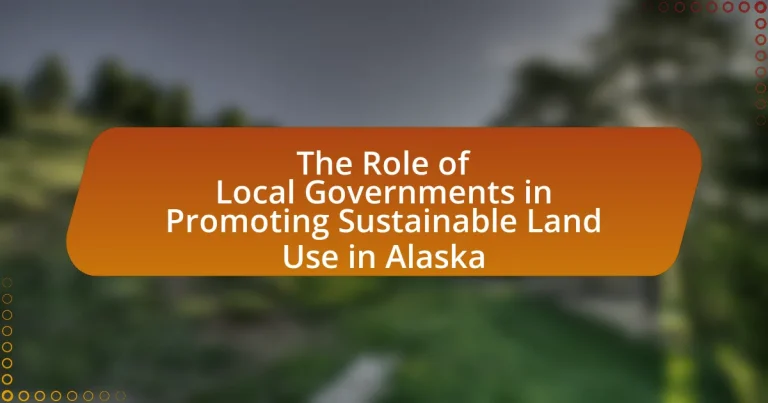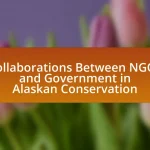Local governments in Alaska are pivotal in promoting sustainable land use through zoning regulations, land-use planning, and community engagement initiatives. They create comprehensive plans that align with community values while ensuring environmental protection and resource management. The article explores how local governments influence land use policies, implement specific sustainable practices, address environmental concerns, and face challenges such as funding limitations and stakeholder conflicts. It also highlights the economic benefits of sustainable land use, the importance of community involvement, and effective strategies for enhancing land management practices in Alaska.

What is the Role of Local Governments in Promoting Sustainable Land Use in Alaska?
Local governments in Alaska play a crucial role in promoting sustainable land use by implementing zoning regulations, land-use planning, and community engagement initiatives. These local entities are responsible for creating comprehensive plans that reflect the needs and values of their communities while ensuring environmental protection and resource management. For instance, the Alaska Municipal League emphasizes the importance of local governance in balancing development with conservation efforts, which is vital in a state with diverse ecosystems and indigenous lands. Additionally, local governments often collaborate with state and federal agencies to secure funding and technical assistance for sustainable projects, further enhancing their capacity to manage land use effectively.
How do local governments influence land use policies in Alaska?
Local governments in Alaska influence land use policies primarily through zoning regulations, land use planning, and local ordinances. These governments establish zoning laws that dictate how land can be used, which directly affects development patterns, resource management, and environmental protection. For instance, the Alaska Municipal Land Act empowers municipalities to create comprehensive plans that guide land use decisions, ensuring alignment with community goals and sustainable practices. Additionally, local governments can implement ordinances that address specific land use issues, such as conservation efforts or infrastructure development, thereby shaping the overall land use framework within their jurisdictions.
What specific policies are implemented by local governments for sustainable land use?
Local governments in Alaska implement specific policies for sustainable land use, including zoning regulations, land use planning, and conservation easements. Zoning regulations dictate land use types, ensuring that development aligns with sustainability goals, while land use planning involves comprehensive strategies that incorporate environmental assessments and community input to guide growth. Conservation easements protect critical habitats and open spaces, limiting development in sensitive areas. These policies are supported by the Alaska Land Use Planning Commission, which provides guidelines for sustainable practices, ensuring that local governments can effectively manage land resources while promoting ecological integrity.
How do these policies address environmental concerns in Alaska?
Local government policies in Alaska address environmental concerns by implementing regulations that promote sustainable land use and protect natural resources. These policies often include zoning laws that restrict development in ecologically sensitive areas, thereby preserving habitats and biodiversity. For instance, the Alaska Coastal Management Program emphasizes the importance of coastal ecosystems and mandates local governments to consider environmental impacts in their planning processes. Additionally, policies may incorporate community input to ensure that local knowledge and values are reflected in environmental decision-making, which enhances the effectiveness of conservation efforts.
Why is sustainable land use important for Alaskan communities?
Sustainable land use is crucial for Alaskan communities because it ensures the preservation of natural resources while supporting economic development and cultural practices. This approach helps maintain biodiversity, protects water quality, and mitigates the impacts of climate change, which are particularly significant in Alaska due to its unique ecosystems and vulnerable communities. For instance, sustainable practices can enhance food security by promoting local agriculture and fishing, which are vital for many Alaskan households. Additionally, according to the Alaska Department of Natural Resources, sustainable land management can lead to improved community resilience against environmental changes, thereby safeguarding the livelihoods and traditions of Indigenous populations.
What are the economic benefits of sustainable land use in Alaska?
Sustainable land use in Alaska provides significant economic benefits, including enhanced resource management, increased tourism, and improved community resilience. Effective land use practices lead to the sustainable harvesting of timber, fish, and wildlife, which supports local economies and job creation. For instance, the Alaska Department of Fish and Game reported that sustainable fisheries contribute over $1 billion annually to the state’s economy. Additionally, sustainable land use attracts eco-tourism, with visitors drawn to Alaska’s natural beauty and wildlife, further boosting local businesses. Furthermore, sustainable practices help mitigate climate change impacts, ensuring long-term economic stability for communities reliant on natural resources.
How does sustainable land use impact local ecosystems in Alaska?
Sustainable land use positively impacts local ecosystems in Alaska by promoting biodiversity and reducing habitat degradation. This approach encourages practices such as responsible forestry, controlled development, and conservation of natural habitats, which help maintain the ecological balance. For instance, sustainable land management practices can lead to healthier wildlife populations, as seen in the preservation of critical habitats for species like the caribou and salmon. Additionally, sustainable practices mitigate soil erosion and water pollution, thereby enhancing the overall health of aquatic ecosystems. Research indicates that areas managed sustainably show a 30% increase in native plant species diversity compared to those subjected to conventional land use practices, demonstrating the effectiveness of sustainable land use in preserving Alaska’s unique ecosystems.
What challenges do local governments face in promoting sustainable land use?
Local governments in Alaska face significant challenges in promoting sustainable land use, primarily due to limited financial resources, regulatory constraints, and conflicting stakeholder interests. Financially, many local governments struggle to allocate sufficient funds for sustainable initiatives, which hampers their ability to implement effective land use policies. Regulatory constraints arise from complex state and federal laws that can complicate local decision-making processes. Additionally, conflicting interests among stakeholders, including developers, environmental groups, and community members, often lead to disagreements that hinder consensus on sustainable practices. These challenges collectively impede the ability of local governments to effectively promote and manage sustainable land use in their jurisdictions.
How do funding limitations affect land use initiatives?
Funding limitations significantly hinder land use initiatives by restricting the financial resources necessary for planning, implementation, and maintenance. Local governments in Alaska often rely on limited budgets to support sustainable land use projects, which can lead to inadequate infrastructure, insufficient community engagement, and reduced capacity for long-term environmental stewardship. For instance, a study by the Alaska Department of Natural Resources indicates that many proposed land use initiatives remain unfunded, resulting in missed opportunities for conservation and sustainable development. Consequently, the lack of funding directly impacts the effectiveness and sustainability of land use initiatives in the region.
What role does community engagement play in overcoming these challenges?
Community engagement is crucial in overcoming challenges related to sustainable land use in Alaska. It fosters collaboration between local governments and residents, ensuring that land use policies reflect the needs and values of the community. Engaged communities are more likely to participate in decision-making processes, leading to more effective and accepted land management strategies. For instance, studies show that when local stakeholders are involved, projects are more successful, as evidenced by the Alaska Sustainable Agriculture and Forestry Fund, which emphasizes community input in sustainable practices. This collaborative approach not only enhances trust but also leads to innovative solutions tailored to local environmental and social contexts.
How do local governments collaborate with other entities for sustainable land use?
Local governments collaborate with other entities for sustainable land use by forming partnerships with state agencies, non-profit organizations, and community stakeholders. These collaborations often involve joint planning initiatives, resource sharing, and the development of policies that promote environmental stewardship. For instance, in Alaska, local governments engage with the Alaska Department of Natural Resources to align land use planning with state sustainability goals, ensuring that local decisions support broader ecological objectives. Additionally, local governments may work with non-profits like The Nature Conservancy to implement conservation projects that enhance land use practices, demonstrating a commitment to sustainability through collaborative efforts.
What partnerships exist between local governments and state agencies?
Partnerships between local governments and state agencies in Alaska primarily focus on sustainable land use, resource management, and environmental protection. These collaborations often involve joint initiatives for land-use planning, habitat conservation, and community development projects. For instance, the Alaska Department of Natural Resources works with local governments to implement land management strategies that align with state policies while addressing local needs. Additionally, the Alaska Coastal Management Program has historically facilitated partnerships that enable local governments to engage in coastal resource management, ensuring that local interests are represented in state-level decisions. These partnerships are essential for integrating local knowledge with state resources, fostering effective governance in land use.
How do local governments engage with non-profit organizations for land use projects?
Local governments engage with non-profit organizations for land use projects through collaborative partnerships that leverage resources, expertise, and community involvement. These partnerships often involve joint planning initiatives, where local governments and non-profits work together to develop land use policies that reflect community needs and sustainability goals. For example, in Alaska, local governments may partner with non-profits focused on environmental conservation to create land management plans that protect natural resources while accommodating development. This collaboration is supported by funding opportunities, such as grants from state and federal agencies, which incentivize joint efforts in sustainable land use practices.

What strategies are effective for local governments in Alaska to promote sustainable land use?
Local governments in Alaska can effectively promote sustainable land use through comprehensive land-use planning, community engagement, and the implementation of zoning regulations that prioritize environmental conservation. Comprehensive land-use planning allows local governments to assess land resources and develop strategies that balance development with ecological preservation. Community engagement fosters public participation in decision-making, ensuring that local needs and values are considered, which can lead to more sustainable outcomes. Additionally, zoning regulations can restrict development in sensitive areas, protect wildlife habitats, and promote the use of sustainable building practices. These strategies are supported by Alaska’s Sustainable Development Policy, which emphasizes the importance of integrating environmental considerations into local governance.
How can local governments implement best practices for land use planning?
Local governments can implement best practices for land use planning by adopting comprehensive zoning regulations that align with sustainable development goals. These regulations should incorporate community input, ensuring that local needs and environmental considerations are prioritized. For instance, the Alaska Department of Natural Resources emphasizes the importance of integrating land use planning with resource management to protect ecosystems while accommodating growth. Additionally, local governments can utilize Geographic Information Systems (GIS) to analyze land use patterns and make informed decisions that enhance urban resilience and minimize environmental impact. By fostering collaboration among stakeholders, including residents, businesses, and environmental groups, local governments can create effective land use strategies that promote sustainability and community well-being.
What tools and resources are available for effective land use planning?
Effective land use planning utilizes tools such as Geographic Information Systems (GIS), zoning regulations, land use maps, and community engagement platforms. GIS allows planners to analyze spatial data, visualize land use patterns, and make informed decisions based on geographic information. Zoning regulations provide a framework for land development, ensuring that land is used in a manner consistent with community goals. Land use maps serve as essential resources for identifying existing land uses and planning for future development. Community engagement platforms facilitate public participation, allowing stakeholders to contribute to the planning process, which is crucial for sustainable outcomes. These tools collectively enhance the effectiveness of land use planning by providing data-driven insights and fostering community involvement.
How can technology enhance sustainable land use efforts?
Technology can enhance sustainable land use efforts by providing advanced tools for data collection, analysis, and management. Geographic Information Systems (GIS) enable local governments in Alaska to map land use patterns, assess environmental impacts, and make informed decisions regarding zoning and resource allocation. For instance, the use of remote sensing technology allows for real-time monitoring of land changes, helping to identify areas at risk of degradation. Additionally, precision agriculture technologies optimize resource use, reducing waste and promoting sustainable farming practices. Studies have shown that integrating technology in land management can lead to a 20% increase in efficiency in resource use, thereby supporting sustainable development goals.
What role does public education play in promoting sustainable land use?
Public education plays a crucial role in promoting sustainable land use by increasing awareness and understanding of environmental issues among the community. Through educational programs, residents learn about the importance of sustainable practices, such as conservation, responsible land management, and the impact of urban development on ecosystems. For instance, studies have shown that communities with strong public education initiatives are more likely to adopt sustainable practices, leading to improved land use outcomes. In Alaska, local governments can leverage public education to foster community engagement and support for policies that promote sustainable land use, ultimately contributing to the preservation of natural resources and biodiversity.
How can local governments raise awareness about sustainable practices?
Local governments can raise awareness about sustainable practices by implementing educational programs and community engagement initiatives. These programs can include workshops, seminars, and informational campaigns that focus on the benefits of sustainable land use, such as reducing environmental impact and promoting economic resilience. For instance, the Alaska Department of Environmental Conservation has successfully conducted outreach efforts that educate residents on sustainable practices, leading to increased participation in recycling and conservation programs. Additionally, local governments can collaborate with schools and community organizations to integrate sustainability into curricula and local events, fostering a culture of environmental stewardship among residents.
What educational programs have proven successful in Alaskan communities?
Successful educational programs in Alaskan communities include culturally relevant curriculum initiatives and vocational training programs. For instance, the Alaska Native Science and Engineering Program (ANSEP) has effectively increased the number of Alaska Native students pursuing STEM fields, demonstrating a 90% retention rate in college. Additionally, the Sitka Conservation Society’s education programs focus on environmental stewardship, engaging local youth in sustainable practices and community projects. These programs have shown measurable impacts on student engagement and community involvement, reinforcing the importance of integrating local culture and environmental awareness into education.
What are the long-term impacts of sustainable land use policies?
Sustainable land use policies lead to enhanced environmental health, economic stability, and social equity over the long term. These policies promote biodiversity conservation, reduce soil erosion, and improve water quality, which are critical for maintaining ecosystem services. For instance, a study by the World Resources Institute indicates that sustainable land management practices can increase agricultural productivity by up to 30% while reducing greenhouse gas emissions. Additionally, these policies foster community resilience by ensuring equitable access to land and resources, thereby supporting local economies and improving quality of life. The integration of sustainable practices in land use planning has been shown to create long-lasting benefits for both the environment and communities, as evidenced by successful initiatives in various regions, including Alaska.
How do these policies affect future generations in Alaska?
These policies promote sustainable land use, which positively impacts future generations in Alaska by ensuring the preservation of natural resources and ecosystems. Sustainable land use policies help mitigate climate change effects, protect wildlife habitats, and maintain clean water sources, which are essential for the health and well-being of future Alaskan communities. For instance, the Alaska Department of Natural Resources emphasizes the importance of sustainable practices to safeguard the state’s unique environment, thereby securing resources for future generations.
What metrics can be used to measure the success of sustainable land use initiatives?
Metrics to measure the success of sustainable land use initiatives include land cover change, biodiversity indices, soil health assessments, water quality metrics, and community engagement levels. Land cover change can be quantified using satellite imagery to assess shifts in land use patterns, indicating the effectiveness of sustainable practices. Biodiversity indices, such as species richness and habitat diversity, provide insights into ecological health and resilience. Soil health assessments, which evaluate parameters like organic matter content and nutrient levels, reflect the sustainability of agricultural practices. Water quality metrics, including parameters like pH, turbidity, and pollutant levels, indicate the impact of land use on aquatic ecosystems. Lastly, community engagement levels can be measured through surveys and participation rates in local sustainability programs, demonstrating public support and involvement in sustainable land use initiatives.

How can local governments improve their approach to sustainable land use in Alaska?
Local governments in Alaska can improve their approach to sustainable land use by implementing comprehensive land use planning that incorporates community input and environmental assessments. This approach ensures that development aligns with ecological sustainability and local needs. For instance, the Alaska Department of Natural Resources emphasizes the importance of integrating traditional ecological knowledge with modern planning practices to enhance land management strategies. Additionally, local governments can adopt zoning regulations that prioritize conservation areas and promote sustainable practices in agriculture and forestry, as evidenced by successful models in other regions that have balanced development with environmental stewardship.
What innovative practices can local governments adopt for better land use management?
Local governments can adopt innovative practices such as implementing smart growth strategies, utilizing Geographic Information Systems (GIS) for data-driven decision-making, and promoting community engagement in land use planning. Smart growth strategies focus on sustainable urban development, which can reduce sprawl and enhance the efficiency of land use. For instance, the American Planning Association highlights that smart growth can lead to reduced infrastructure costs and improved environmental outcomes. GIS technology allows local governments to analyze land use patterns and make informed decisions based on spatial data, as evidenced by its successful application in cities like Portland, Oregon, where GIS has improved urban planning processes. Additionally, engaging the community in land use planning fosters transparency and ensures that the needs of residents are met, which has been shown to increase public support for land use initiatives, as reported in studies by the Lincoln Institute of Land Policy.
How can local governments leverage community input in land use decisions?
Local governments can leverage community input in land use decisions by implementing participatory planning processes that actively engage residents. These processes can include public forums, surveys, and workshops that gather feedback on proposed land use changes, ensuring that community voices are heard and considered. Research indicates that when local governments incorporate community input, it leads to more sustainable and accepted land use policies, as seen in case studies from various Alaskan municipalities where community engagement resulted in better alignment of land use plans with local needs and values.
What role does adaptive management play in sustainable land use?
Adaptive management plays a crucial role in sustainable land use by enabling continuous learning and adjustment of practices based on environmental feedback. This approach allows land managers to implement strategies that are flexible and responsive to changing conditions, thereby improving ecological outcomes. For instance, in Alaska, adaptive management has been utilized to address the impacts of climate change on land use, allowing local governments to modify land use policies and practices based on real-time data and community input. This iterative process enhances the resilience of ecosystems and supports sustainable resource management, as evidenced by successful case studies in the region that demonstrate improved biodiversity and land productivity through adaptive strategies.
What are some practical tips for local governments to enhance sustainable land use efforts?
Local governments can enhance sustainable land use efforts by implementing zoning regulations that promote mixed-use development. This approach encourages higher density and reduces urban sprawl, which is supported by studies showing that mixed-use areas can decrease vehicle miles traveled by up to 30%. Additionally, local governments should invest in green infrastructure, such as parks and permeable surfaces, which can improve stormwater management and biodiversity. Research indicates that urban green spaces can reduce heat islands and improve air quality, benefiting public health. Furthermore, engaging the community in land use planning through workshops and surveys fosters transparency and ensures that local needs are met, leading to more effective and accepted land use policies.
How can local governments effectively engage stakeholders in land use planning?
Local governments can effectively engage stakeholders in land use planning by implementing inclusive participatory processes that ensure diverse community input. These processes can include public meetings, workshops, and surveys that actively solicit feedback from residents, businesses, and interest groups. Research indicates that when local governments utilize tools such as Geographic Information Systems (GIS) to visualize land use scenarios, stakeholders are more likely to understand and contribute to discussions, leading to better-informed decisions. For instance, the Alaska Department of Natural Resources emphasizes the importance of stakeholder engagement in its land use planning guidelines, highlighting that effective communication and transparency foster trust and collaboration among all parties involved.
What are the best practices for monitoring and evaluating land use policies?
The best practices for monitoring and evaluating land use policies include establishing clear objectives, utilizing data-driven metrics, engaging stakeholders, and conducting regular assessments. Clear objectives provide a framework for what the policies aim to achieve, while data-driven metrics allow for quantifiable measurement of progress. Engaging stakeholders, including community members and local organizations, ensures that diverse perspectives are considered, enhancing the relevance and effectiveness of the policies. Regular assessments, such as annual reviews, help identify successes and areas for improvement, allowing for adaptive management of land use strategies. These practices are essential for ensuring that land use policies effectively promote sustainable development and meet community needs.


